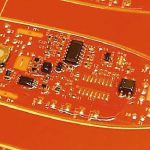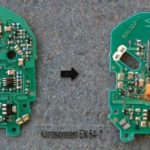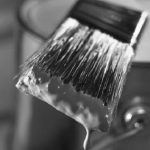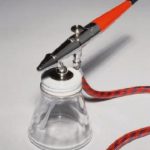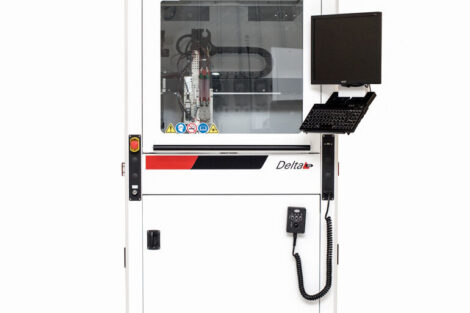For decades, the need for smaller, lighter more integrated systems has driven developments in the electronics industry. The result is that today’s electronic assembly is typically small and densely populated with tiny components and fine-line circuitry.
Ad van Dinter, CEO, DIMA SMT Systems NL. B.V.
At the same time, demands placed on quality and performance have never been so high. Home, car and mobile electronic appliances can be subjected to any degree of rough treatment in all kinds of environments, yet they are expected to continue to perform fully and properly throughout a reasonable working life. It follows that robustness and reliability are non-negotiable parts of the product offering.
The logical consequence of miniaturisation is increased fragility – smaller components, for example, are generally more delicate. Add to this the fact that even at very low concentrations, corrosive contaminants can attack and even cause failure in tightly-packed copper tracks, and it is clear that electronics manufacturers have their work cut out if they are to meet the market’s stringent demands.
The solution to this growing problem is to coat electronic assemblies with a conformal coating; a protective barrier that enhances physical resis- tance and keeps contaminants out. This is hardly new – military, railway and other high-specification electronics products were already being coated years ago to enhance their performance. At that time, this was a manual task involving dip or spray coating, or fine pencil work, and it was labour-intensive, difficult, messy and environmentally unsafe.
Conformal coating today
Thanks to significant developments in technology and new materials, this is no longer the case. The growing needs of today’s electronics assembly industry are amply satisfied by a range of economical, clean, environmentally safe solutions that enhance the performance of their products by increasing their resistance to shocks, humidity and corrosion.
Shock resistance can be improved by a thick, non-elastic coating that firmly adheres to the board and components and works as a stress reliever, while humidity resistance and corrosion protection can be achieved using thin barrier coatings that keep contaminants out and prevent electromigration.
In this article we explore the various types of coatings and application methods available to today’s electronics assembly companies.
Coating types …
Solvent-based
The principal advantages of these materials are their low cost and mechanical resistance. They can also be removed using solvents for repair work. They are, however, relatively inflexible, hazardous, environmentally unsound and produce potentially explosive fumes during curing that require careful handling. At 8–10 min at 80 ºC, curing times are also relatively long. Their low price should also be seen in the light of the fact that they contain just 20 % solids, so five times more material is required to produce the same coating thickness as a 100 % solids coating.
Silicone-based
Flexible but mechanically delicate unless handled properly, these coatings can be removed easily for repair. They cure relatively quickly, taking just 2–5 minutes at 60 °C. In some cases, cure may require some ambient moisture – an RH of 20–35 % is typical. At 100 % solids content, they eliminate hazardous fumes and materials and although they cost twice the price of solvent based coatings, 80 % less material is required to create the same coating thickness as a solvent or water-based equivalent.
UV curing
These mechanically resistant non-hazardous materials cure faster than any of the alternatives, at up to 7,5 m/min in-line. The advantages of these coatings include their robustness, combined with the fact that they can be removed with solvents for repair work. Disadvantages include cost: they are the most expensive of all the conformal coating materials, and the fact that coating “hidden” under components does not cure, a problem that is resolved in some twin curing systems with a secondary heat-cure phase. They can also emit an unpleasant smell during curing.
Water-based
Like their solvent-based counterparts, these coatings are cheap, very robust, and can be removed using solvents for repair work. They are also inflexible, and contain just 20 % solids, with all the cost issues that this entails. Cure times are long at 20 minutes, but the process requires nothing other than a normal working environment, and the materials are odorless.
… and who uses them
The use of solvent-based materials is no longer allowed in the USA, so they have been replaced by water-based coatings and silicones, which are extensively used in the automotive industry.
Europe and Asia are still using solvent-based coatings but are moving towards water-based materials.
UV coatings are ideal where extremely high throughput is required.
Coating thickness
It makes economic sense to keep coatings as thin as possible, but the optimum coating thickness depends of course on the type of protection required.
A 0,1 mm layer, for example, will suffice for simple corrosion protection, but will be inadequate on a board that must be protected from high voltages or physical stresses. In some cases, components must be completely potted.
With this in mind, some manufacturers prefer to invest in flexible coating equipment that can handle all eventualities.
Coating methods
Manual brush coating
The most labor-intensive and imprecise way to apply conformal coatings, this is generally used where other methods are unavailable, to produce prototypes or small production runs. It is messy, inaccurate and expensive on materials. It also produces an undefined coating thickness.
Dip coating
This older, now seldom-used method deposits a thick coating on the entire assembly, so switches, connectors and other parts that are not to be coated must be protected beforehand with preformed silicon covers. While the coating operation itself is fast, preparations take longer, it uses a lot of material, and it is difficult to automate.
Spray coating
Involving spray pistols or cans, this method has the advantage of keeping coating thickness down and is best suited for prototype or small production runs. Here too, the coating operation is fast, but preparation takes longer as all areas that are not to be coated must be masked off beforehand. Difficult to automate, this method requires a special coating cabin to prevent contamination of the surrounding work environment.
Selective spray coating
Today’s most commonly-used conformal coating method uses a computer-controlled robot in conjunction with special selective coating valves to ensure that only predefined areas are coated. Each robot may be connected to multiple valves with different chemicals, enabling manufacturers to use the same machine to pot one part of an assembly and thin coat another in the same coating run. Although the coating phase proper takes longer, there is no need to prepare the board, and programming and product changeover are fast. This method is easily automated, and, being a selective spray method, it uses a minimum of coating material.
Migration and jet/ultrasonic coating
Compared to selective spray coating, these methods are expensive and little-used, but warrant a brief mention nonetheless.
During migration coating, the coating material migrates under vacuum onto the board and completely seals it.
Jet coating uses the same principle as inkjet printing in that a piezo crystal, deformed by an electric current, squeezes out dots of material onto small preselected areas.
Curing methods
Air curing
Silicone and solvent-based coatings can be left to cure at room temperature. This requires space and time, and it can be unpleasant as evaporating solvents and odors contaminate the curing area. This is suitable only for prototypes or repairs.
Heat curing
Solvent-based and some silicone coatings cure on exposure to heat. Heated cabinets may be used for prototype work, but production volumes typically use 2.4m-long IR-heated curing tunnels. During the cure phase, which can last between 2 and 10 minutes, solvent fumes, which are heavier than air, drop to the bottom of the curing oven, where they must be extracted by explosion-proof equipment.
Heat and moisture
Some silicone coatings need a certain degree of humidity to activate the curing process. This can be supplied by injecting steam into the curing tunnel.
UV curing
The most expensive curing method is also the fastest: on exposure to UV light. UV materials cure almost instantaneously. The drawback is that any conformal coating that gets under the components remains in the shadow and will not polymerise. For this reason, most UV materials use heat as a secondary cure method. Fortunately, the light source generates enough heat energy to activate the curing process, and because the problem areas cannot be touched, the boards can be handled as soon as they exit the curing tunnel, which is typically 1,5 m long.
Who should be conformal coating their products?
Whether conformal coating is appropriate for any given electronics manufacturer depends on that manufacturer’s needs and economic restraints, and those of its clients. Manufacturers in doubt can turn to tests such as thermal cycling, thermal shock, temperature/humidity and vibration tests to see whether conformal coating will improve their product performance. Salt-fog testing is also a good indicator of the corrosive, electrical, and physical effects of a humid, salt-bearing atmosphere on any given assembly’s electrical functions, and of the protection afforded by a conformal coating.
Manufacturers can also turn to materials suppliers for advice. Companies such as Humiseal, Dow Corning, Dymax, Emerson & Cumming, Lackwerke Peters and Shin-Etzu all offer a wide range of coatings and with their expertise they are well placed to identify the right materials combinations for any application.
Among the suppliers of coating equipment, DIMA SMT Systems NL. B.V. offers a full range of affordable coating solutions ranging from a small one-head table top robot to a fully automated in-line four axis coating robot with up to four different valves combined with curing ovens and board handlers. DIMA makes its test laboratories available to its clients to identify the best solution for their applications.
One thing is certain: the materials and equipment available today make conformal coating an integral, well-controlled step in any assembly process, and it is likely to become more common as the market places increasingly stringent demands on electronics manufacture.
EPP EUROPE 416
Zusammenfassung
Heute sind die elektronischen Baugruppen üblicherweise klein und dicht bestückt mit winzigen Komponenten und Schaltungen, die sie technisch und chemisch anfälliger machen, wo gerade die Forderungen nach Funktionalität und Zuverlässigkeit noch niemals so hoch waren. Obwohl sie einer rauen Behandlung und selbst ätzenden Umgebungen ausgesetzt werden, sollen sie einwandfrei über eine angemessene Lebensdauer funktionieren.
Schutzbeschichtungen werden seit Jahrzehnten verwendet um die Funktionalität und Zuverlässigkeit von hoch spezifizierten Baugruppen zu steigern durch Verbesserung ihrer Schock-, Feuchtigkeits- und Korrosionsbeständigkeit. Heute machen neue Materialien und Equipment das selektive Beschichten einfacher und wirtschaftlicher für einen neuen und größeren Bereich elektronischer Anwendungen.
résumé
Aujourd’hui, en général, les composants électroniques sont petits et hermétiquement alimentés de composants et de connexions minuscules qui les rendent délicats sur le plan technique et chimique, là où justement, les exigences en matière de fonctionnalité et de fiabilité n’ont jamais été aussi pointues. Même s’ils sont exposés à un traitement rigoureux et un environnement corrosif, ils doivent fonctionner à la perfection tout au long d’une durée de vie appropriée.
Les revêtements de protection sont utilisés depuis des siècles, afin d’augmenter la fonctionnalité et la fiabilité de composants hautement spécifiés, grâce au perfectionnement de leur résistance aux chocs, à l’humidé et à la corrosion. Aujourd’hui, dans un nouveau secteur plus étendu d’applications électroniques, les nouveaux matériaux et les nouveaux équipements rendent le revêtement sélectif plus simple et plus économique.
La tipica scheda elettronica di oggi è piccola e densamente popolata da componenti piccolissimi e da conduttori finissimi. Questo la rende molto fragile, sia sotto il profilo fisico che chimico. Eppure, le richieste di funzionalità e di affidabilità non sono mai state così elevate come oggi. Nonostante il fatto che questa scheda verrà maneggiata, a volte, in maniera grossolana, e potrebbe essere esposta ad ambienti avversi e perfino anche corrosivi, dovrà tuttavia garantire una funzionalità perfetta durante una vita di durata ragionevole. I Conformal coatings sono stati usati da diecine di anni per migliorare le prestazioni e l’affidabilità di schede elettroniche avanzate, grazie al potenziamento della loro resistenza all’urto, all’umidità ed alla corrosione. Adesso, una nuova generazione di materiali ed attrezzature rendono il processo di conformal coating più semplice, più economico e più idoneo per un nuovo e più ampio raggio di applicazioni elettroniche.
Share:


